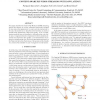Free Online Productivity Tools
i2Speak
i2Symbol
i2OCR
iTex2Img
iWeb2Print
iWeb2Shot
i2Type
iPdf2Split
iPdf2Merge
i2Bopomofo
i2Arabic
i2Style
i2Image
i2PDF
iLatex2Rtf
Sci2ools
ICMCS
2007
IEEE
2007
IEEE
Content-Aware P2P Video Streaming with Low Latency
This paper describes the Stanford P2P Multicast (SPPM) streaming system that employs an overlay architecture specifically designed for low delay video applications. In order to provide interactivity to the user, this system has to keep the end-to-end delay as small as possible while guaranteeing a high video quality. A set of complimentary multicast trees is maintained to efficiently relay video traffic and a Congestion-Distortion Optimized (CoDiO) scheduler prioritizes more important video packets. Local retransmission is employed to mitigate packet loss. Real-time experiments performed on the Planet-Lab show the effectiveness of the system and the benefits of a content-aware scheduler in case of congestion or node failures.
Related Content
| Added | 03 Jun 2010 |
| Updated | 03 Jun 2010 |
| Type | Conference |
| Year | 2007 |
| Where | ICMCS |
| Authors | Pierpaolo Baccichet, Jeonghun Noh, Eric Setton, Bernd Girod |
Comments (0)

